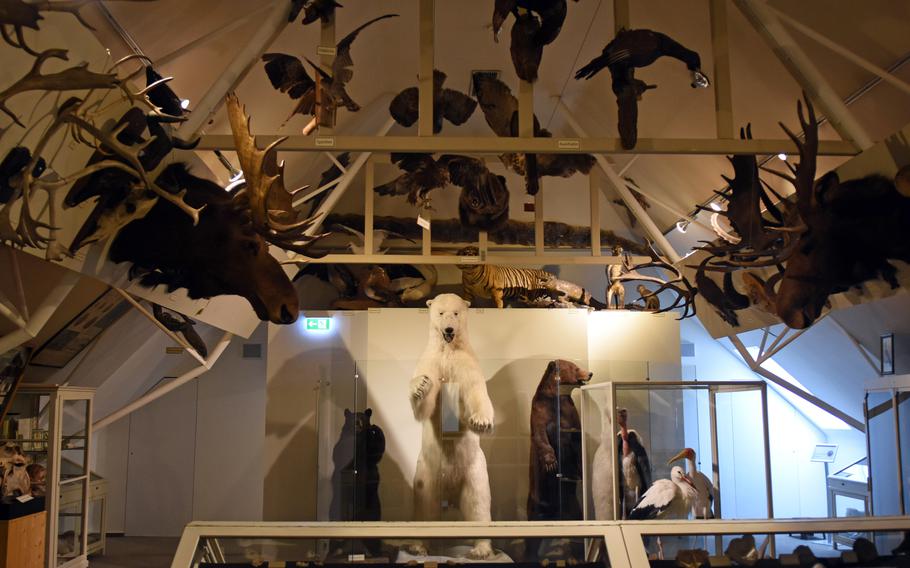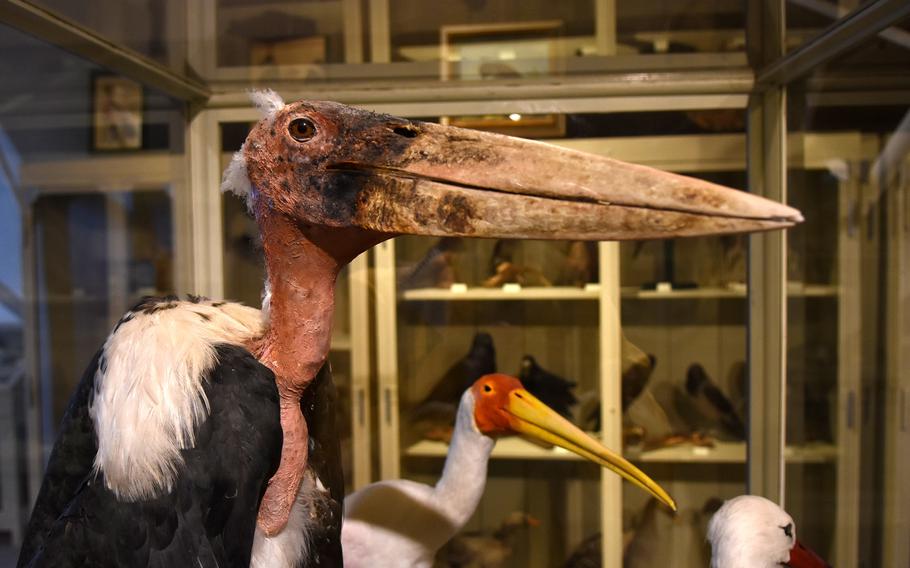
Walk among an extensive collection of preserved animals and birds on the top floor of the Palatinate Museum of Natural History in Bad Duerkheim, Germany. (Jennifer H. Svan/Stars and Stripes)
Visiting the Palatinate Museum of Natural History is bound to interest its patrons for hours, regardless of whether they can read German or not.
I’m in the latter category, and I loved this museum. The Google Translate app on my phone allowed me to read the signs that lack explanatory material in English.
I found something fascinating to gaze at or inspect in every room, such as a giant hornet’s nest, a display of brilliant glow-in-the-dark minerals and the 13-foot-long skeleton of a tiger python.

Get a close-up look at the remnants of a large hornet nest at the Palatinate Museum of Natural History in Bad Duerkheim, Germany. A buzzing sound greets visitors as they walk by the display. (Jennifer H. Svan/Stars and Stripes)
The museum is housed in an old mill on the banks of the Isenach River, along a quiet residential street on the outskirts of Bad Duerkheim.
A local doctor founded the museum in the 1840s with the aim of informing villagers about medicine and hygiene, according to its website.
Some original exhibits are still on display and may make you shudder: lifelike models of children infected with typical diseases of the era, such as scarlet fever and diphtheria.
But most of the exhibits, spread across four floors, relate to the natural history of the region, with an emphasis on animals. The fauna ranges from a collection of small birds to the huge, 120,000-year-old pelvis bone of a European elephant found in Speyer.

Visitors can get a close-up look at various preserved specimens, including this fearsome goliath birdeater spider, under a microscope at the Palatinate Museum of Natural History in Bad Duerkheim, Germany. (Jennifer H. Svan/Stars and Stripes)
Each collection has a theme. There’s one on insects, another on the geology of the Pfalz and the variety of rocks found in the earth here, including pieces of volcanic rock dating back 296 million years. Others include botany, mushrooms, mining and minerals.
In one room, you can glimpse the animals you might encounter in the vast Pfalz forest, from a wild boar, wildcat and fox to several species of woodpeckers. Despite being preserved behind a glass box, the critters look lifelike.
One of the museum’s best-known exhibits is the Kraehenberg meteorite, which fell from the sky and landed in the Pfalz village of the same name in 1869.

A stuffed marabou, foreground, and a nimmersatt are part of the large collection of birds and animals on display at the Palatinate Museum of Natural History in Bad Duerkheim, Germany. (Jennifer H. Svan/Stars and Stripes)
The bang caused as it entered Earth’s atmosphere was said to have been heard as far as Wiesbaden, about 62 miles away, according to the museum. The 32-pound chunk of gray rock is estimated to be 4.7 billion years old.
In the attic is the so-called “room of curiosities.” A stuffed polar bear on its hind legs seems to peer at you when you walk in, one of several “grim trophies” from the days of colonial hunting, according to the museum’s own description.
The ecletic collection ranges from a giraffe skull and teeth to fish heads and exotic beetles. This is also where the aforementioned child mannequins are housed. Their lifelike qualities gave me a start.

Among the more unusual specimens in the Palatinate Museum of Natural History in Bad Duerkheim, Germany, is a mummified cat. Much of the museum’s exhibits showcase natural items from the Pfalz region, from fossils to insects. (Jennifer H. Svan/Stars and Stripes)
For real kids, the museum has several hands-on activities, such as looking at spiders preserved in plastic cases under a microscope, touching animal skins and finding camouflaged insects.
Bring a few extra euros to buy a souvenir or two in the museum’s small gift shop.

The Palatinate Museum of Natural History in Bad Duerkheim, Germany, has exhibits about the geology, flora and fauna and natural ecological relationships found in the Pfalz region. (Jennifer H. Svan/Stars and Stripes)
Palatinate Museum of Natural History
Address: Kaiserslauterer Str. 111, 67098 Bad Duerkheim
Cost: Admission is 3 euros for adults, 2 euros for students and children. A family ticket is 6 euros.
Hours: Tuesday to Sunday, 10 a.m. to 5 p.m.; Monday closed.
Information: Phone: +49 (0) 06322-9412-20; email: info@pfalzmuseum.bv.pfalz.de; online: pfalzmuseum.de
Jennifer Svan